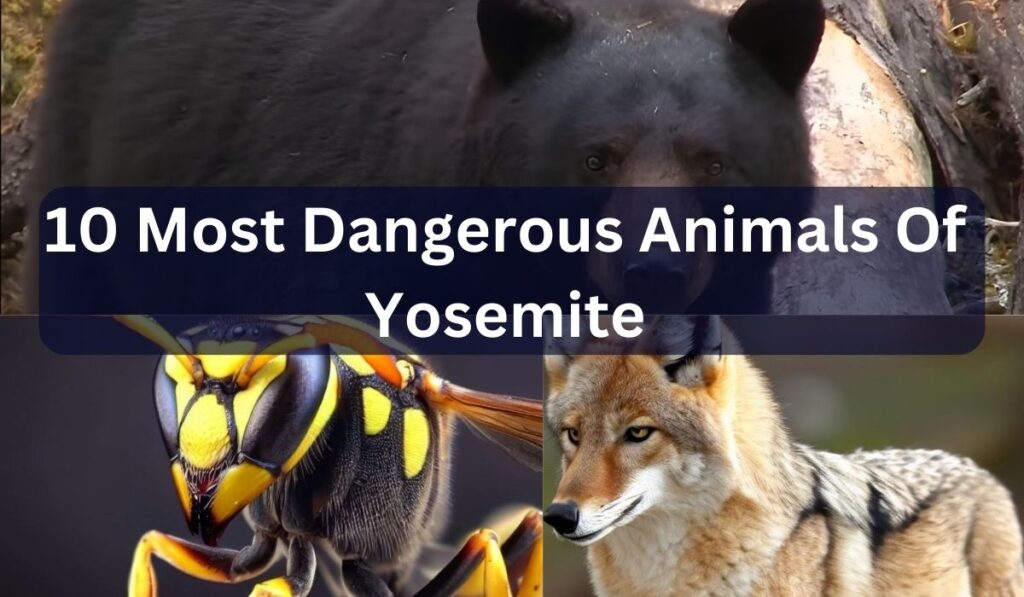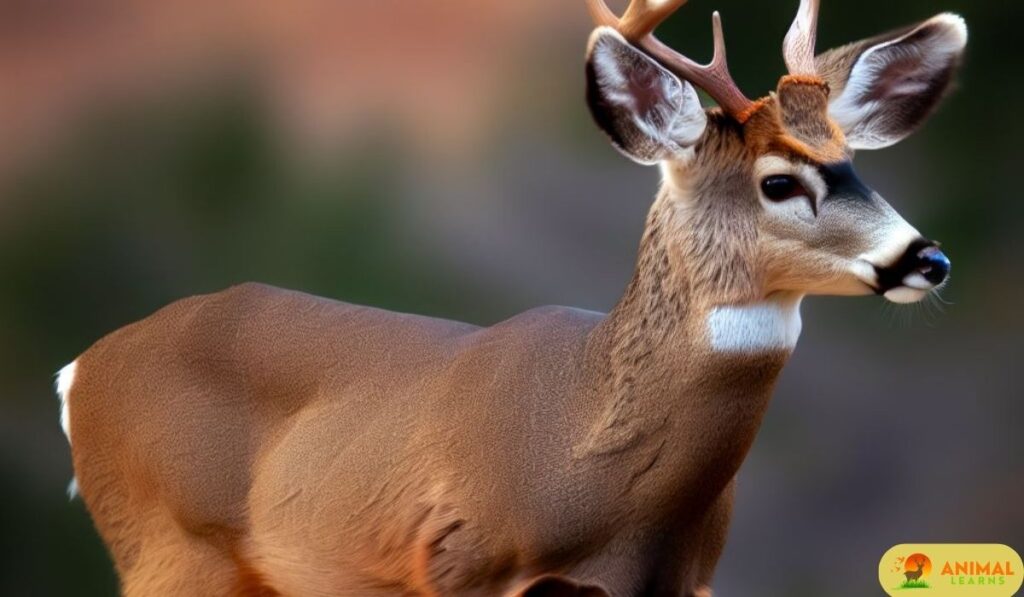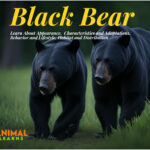10 Most Dangerous Animals Of Yosemite

Most Dangerous Animals of Yosemite: Yosemite National Park, nestled in California’s Sierra Nevada mountains, boasts diverse flora and fauna. While it attracts millions of visitors each year, it is important to remember that it is also home to a variety of dangerous animals.
It is home to a diverse range of wildlife, making it a fascinating destination for nature enthusiasts. Among the park’s residents, bears, both black and grizzly, roam freely. These magnificent creatures are often the subject of curiosity, with many wondering just how common bear attacks are in Yosemite.
In this article, we will explore the ten most dangerous animals of Yosemite, providing detailed information about each species and their potential threats.
Most Dangerous Animals Of Yosemite
Contents
| # | Animal Name |
| 1 | Mountain Lion |
| 2 | Black Bear |
| 3 | Western Diamondback Rattlesnake |
| 4 | Gray Wolf |
| 5 | Coyote |
| 6 | Northern Pacific Rattlesnake |
| 7 | Mule Deer |
| 8 | Yellow Jacket Wasps |
| 9 | Garter Snake |
| 10 | Western Scorpion |
Mountain Lion

The mountain lion, also known as the cougar or puma, tops the list as one of Yosemite’s most dangerous animals. These graceful yet deadly predators can weigh up to 200 pounds and possess incredible strength and agility.
Though elusive and typically avoiding human contact, mountain lion attacks, although rare, can be fatal. It’s crucial to remain vigilant and follow park regulations when hiking or camping in areas known for their presence.
Black Bear

The American black bear, a common sight in Yosemite, is another formidable creature that demands respect. While these large mammals generally shy away from humans, they can become dangerous if they feel threatened or if food is involved.
It is essential to follow bear safety guidelines, such as proper food storage and maintaining a safe distance, to minimize encounters and prevent any potential harm.
Western Diamondback Rattlesnake

Yosemite’s rugged terrain and warm climate provide an ideal habitat for the western diamondback rattlesnake, a venomous reptile. These snakes possess potent venom and the ability to deliver a fast and dangerous bite.
Keep your distance, remain on designated paths, and take caution in rocky areas, especially during warm seasons when these snakes are most active.
Gray Wolf

While extremely rare in Yosemite, the reintroduction of gray wolves to nearby regions has increased the potential for their presence in the park.
Gray wolves are apex predators with powerful jaws and exceptional hunting abilities. Although their populations are recovering, it is vital to treat these animals with caution and report any sightings to park authorities.
Coyote

Coyotes are adaptable and opportunistic predators found throughout Yosemite. While they generally avoid conflicts with humans, interactions can occur, particularly in developed areas where they search for food.
Always keep a safe distance and refrain from feeding or approaching these animals to prevent them from becoming habituated to human presence.
Northern Pacific Rattlesnake

Among the most dangerous animals in Yosemite National Park are the northern Pacific rattlesnakes, often found in rocky or wooded areas.
Their venom can be dangerous, leading to severe pain, tissue damage, and other complications. Exercise caution when exploring these environments and refrain from disturbing or handling them.
Mule Deer

During the mating season, some of the most dangerous animals of Yosemite, like Mule deer, may seem docile and benign but can still pose significant danger.
Bucks become territorial and engage in fierce battles, utilizing their sharp antlers as weapons. Keep a safe distance during mating season and avoid approaching these magnificent creatures when they display signs of aggression.
Yellow jacket wasps

These aggressive wasps have a painful sting and are known to be particularly bothersome during the summer months in Yosemite. Avoid sweet food or drink in open containers, as they are attracted to sugar and can become aggressive when disturbed.
Garter Snake

While most species of garter snakes are harmless, some are mildly venomous. They generally avoid humans but can still deliver a bite if provoked or handled. Treat them with respect, appreciate their presence from a safe distance, and avoid any interaction to prevent unnecessary injuries.
Western Scorpion

Found in the park’s dry, rocky areas, the western scorpion is another creature to be aware of. Their venomous stingers can cause painful bites that might require medical attention. Take caution when exploring rocky habitats, especially at night when they are most active.
While Yosemite National Park is undeniably captivating, visitors must acknowledge the potential dangers that exist alongside its natural beauty.
Educating oneself on the most dangerous animals in the area is a crucial step towards ensuring safety and maintaining a harmonious coexistence with these remarkable creatures.
Most dangerous animals of Yosemite, While these animals pose potential risks, it is important to remember that most encounters with wildlife in Yosemite are peaceful and should be enjoyed at a respectful distance.
Visitors must practice responsible behavior in the park, follow park regulations, and always respect the natural habitat of these animals for a safe and fulfilling experience.
Attributes: Dangerous and Deadly
While Yosemite’s natural beauty is captivating, it’s important to be aware of potential dangers. Among the creatures that call Yosemite home are poisonous snakes, like rattlesnakes, which can be a significant concern for hikers and outdoor enthusiasts.
Visitors are often curious about how dangerous the park truly is and why it’s considered a potentially hazardous environment.
Understanding the habits and behaviors of these dangerous animals is key to ensuring safety in the wilds of Yosemite National Park. While bear attacks are relatively rare, understanding the risks associated with encounters with these powerful creatures is crucial for hikers and campers.
Additionally, there is curiosity about whether are there wolves in Yosemite, as these elusive predators can be both awe-inspiring and elusive.
FAQs
Are there any dangerous animals in Yosemite?
Yes, Yosemite is home to some dangerous animals, including bears and rattlesnakes.
Are Yosemite bears dangerous?
While Yosemite bears are not inherently dangerous, they can become so if they feel threatened or if they associate humans with food. Proper precautions are necessary to minimize risks.
Are coyotes dangerous in Yosemite?
Coyotes in Yosemite can be considered potentially dangerous, especially if they lose their natural fear of humans due to interactions with people or being fed by them.
Are there dangerous snakes in Yosemite?
Yes, Yosemite is home to some dangerous snakes, including rattlesnakes, which are venomous.
Does Yosemite have mountain lions?
Yes, Yosemite does have mountain lions, also known as cougars or pumas. While encounters are rare, they can pose a risk if approached closely.
Does Yosemite have wolves?
There is no confirmed population of wolves in Yosemite at the time of my last knowledge update in September 2021, but there has been interest in their reintroduction to the area.












